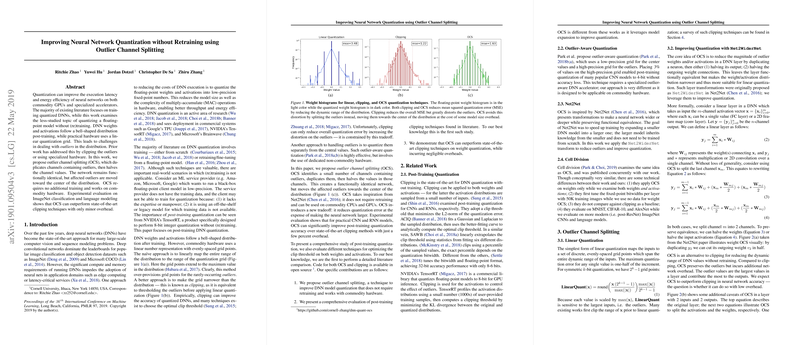Improving Neural Network Quantization Using Outlier Channel Splitting: A Formal Overview
The paper "Improving Neural Network Quantization without Retraining using Outlier Channel Splitting" presents an advanced exploration of post-training quantization techniques for deep neural networks (DNNs). This work targets the challenge of quantizing floating-point models without retraining, a practical scenario often faced by ML service providers who operate black-box client models and lack access to the training data.
Problem Statement and Methodology
Quantization aims to reduce the execution latency and energy costs of DNNs by converting floating-point weights and activations to low-precision representations. The authors tackle the issue of outliers in DNN weight distributions, which can escalate mean squared quantization error (MSE). Unlike conventional approaches that rely on clipping these outliers, the paper introduces the Outlier Channel Splitting (OCS) technique.
OCS duplicates channels with outliers and halves the values, creating a functionally equivalent network while centralizing outliers within the distribution. This modification does not necessitate retraining and is compatible with current hardware structures.
Empirical Evaluation and Insights
The implementations and evaluations span ImageNet-based convolutional neural networks (CNNs) such as VGG16, ResNet-50, DenseNet-121, and Inception-V3, in addition to RNNs for LLMing. The results are compelling:
- OCS surpasses state-of-the-art clipping methods at weights quantized to lower bitwidths, demonstrating significant accuracy retention with negligible memory overhead.
- At 5 and 6 bits, the OCS method with modest expansion ratios outperformed clipping by margins reaching up to 13% for some models.
- Combining OCS with clipping — particularly at very low precision — yields superior results compared to individual methods.
- Activation quantization using OCS was less effective, likely due to profiling inaccuracies, but an oracle version demonstrated potential.
Technical Distinctions
The methodology offers notable improvements over existing practices by addressing outlier challenges without necessitating specialized hardware. The quantization-aware splitting mitigates potential increases in quantization error and promises a more efficient representation of the neural network data.
Implications and Future Directions
The proposed OCS method significantly enhances the scope of neural network deployment in real-world applications where retraining is impractical. It aligns well with contemporary commercial systems like NVIDIA’s TensorRT, suggesting broad applicability.
Future research directions may involve refining channel selection strategies and integrating OCS into training processes. These refinements could optimize weight distributions for quantization, potentially elevating model accuracy in quantized operations. Moreover, expanding the paper into dynamic selection techniques for activations could enhance OCS's utility in those contexts.
This paper represents an incremental yet substantial advancement in the optimization of post-training quantization, potentially influencing both academic research and industry practices.
